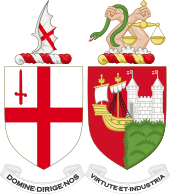
Back Great Western Railway AN غريت ويسترن ريلوي Arabic Great Western Railway Catalan Isambard Kingdom Brunel#Great Western Railway Czech Rheilffordd y Great Western Welsh Great Western Railway German Great Western Railway Spanish Great Western Railway French Great Western Railway Hungarian Great Western Railway Italian
 | |||||||||||||||||||||
 Map of the railway pre-grouping (1920) | |||||||||||||||||||||
 Map of the railway post-grouping (1926) | |||||||||||||||||||||
| History | |||||||||||||||||||||
|---|---|---|---|---|---|---|---|---|---|---|---|---|---|---|---|---|---|---|---|---|---|
| 1835 | Act of incorporation | ||||||||||||||||||||
| 1838 | First train ran | ||||||||||||||||||||
| 1869–92 | 7 ft 1⁄4 in (2,140 mm) Brunel gauge changed to 4 ft 8+1⁄2 in (1,435 mm) standard gauge | ||||||||||||||||||||
| 1903 | Start of road motor services | ||||||||||||||||||||
| 1923 | Keeps identity though the Grouping | ||||||||||||||||||||
| 1935 | Centenary | ||||||||||||||||||||
| 1948 | Nationalised | ||||||||||||||||||||
| Successor organisation | |||||||||||||||||||||
| 1948 | British Rail, Western Region | ||||||||||||||||||||
| Key locations | |||||||||||||||||||||
| Headquarters | Paddington station, London | ||||||||||||||||||||
| Locale | England; Wales | ||||||||||||||||||||
| Workshops | Swindon Wolverhampton | ||||||||||||||||||||
| Major stations | Birmingham Snow Hill Bristol Temple Meads Cardiff General London Paddington Reading General | ||||||||||||||||||||
| |||||||||||||||||||||
The Great Western Railway (GWR) was a British railway company that linked London with the southwest, west and West Midlands of England and most of Wales. It was founded in 1833, received its enabling act of Parliament on 31 August 1835 and ran its first trains in 1838 with the initial route completed between London and Bristol in 1841. It was engineered by Isambard Kingdom Brunel, who chose a broad gauge of 7 ft (2,134 mm)—later slightly widened to 7 ft 1⁄4 in (2,140 mm)—but, from 1854, a series of amalgamations saw it also operate 4 ft 8+1⁄2 in (1,435 mm) standard-gauge trains; the last broad-gauge services were operated in 1892.
The GWR was the only company to keep its identity through the Railways Act 1921, which amalgamated it with the remaining independent railways within its territory, and it was finally merged at the end of 1947 when it was nationalised and became the Western Region of British Railways.
The GWR was called by some "God's Wonderful Railway" and by others the "Great Way Round" but it was famed as the "Holiday Line", taking many people to English and Bristol Channel resorts in the West Country as well as the far southwest of England such as Torquay in Devon, Minehead in Somerset, and Newquay and St Ives in Cornwall. The company's locomotives, many of which were built in the company's workshops at Swindon, were painted a middle chrome green colour while, for most of its existence, it used a two-tone "chocolate and cream" livery for its passenger coaches. Goods wagons were painted red but this was later changed to mid-grey.
Great Western trains included long-distance express services such as the Flying Dutchman, the Cornish Riviera Express and the Cheltenham Spa Express. It also operated many suburban and rural services, some operated by steam rail motors or autotrains. The company pioneered the use of larger, more economic goods wagons than were usual in Britain. It ran ferry services to Ireland and the Channel Islands, operated a network of road motor (bus) routes, was a part of the Railway Air Services, and owned ships, canals, docks and hotels.
- ^ MacDermot, E T (1927). "Appendix 1". History of the Great Western Railway, volume I 1833-1863. London: Great Western Railway. Reprinted 1982, Ian Allan, ISBN 0-7110-0411-0
- ^ MacDermot, E T (1931). "Appendix 1". History of the Great Western Railway, volume II 1863-1921. London: Great Western Railway. Reprinted 1982, Ian Allan, ISBN 0-711004-12-9
- ^ "A brief review of the Company's hundred years of business". Great Western Railway Magazine. 47 (9). Great Western Railway: 495–499. 1935.
- ^ The Railway Year Book for 1920. London: The Railway Publishing Company Limited. 1920. p. 154.
- ^ The Railway Year Book for 1926. London: The Railway Publishing Company Limited. 1926. pp. 154–172.
© MMXXIII Rich X Search. We shall prevail. All rights reserved. Rich X Search